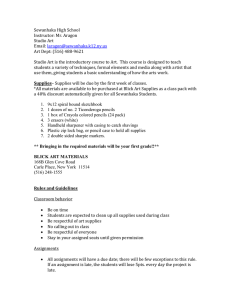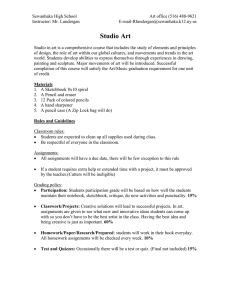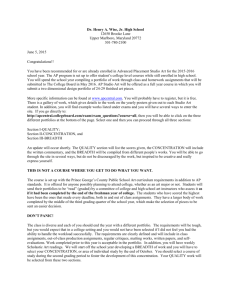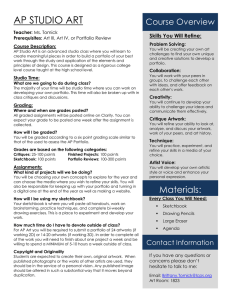The Summer Assignments The Importance of the Summer Assignment
advertisement
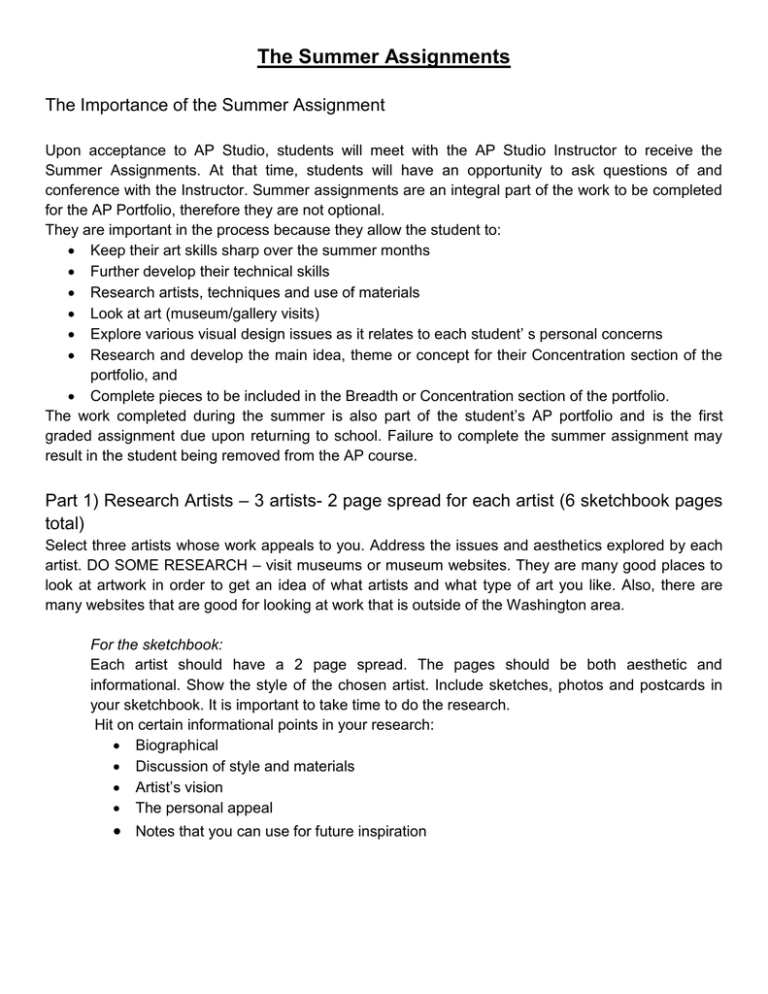
The Summer Assignments The Importance of the Summer Assignment Upon acceptance to AP Studio, students will meet with the AP Studio Instructor to receive the Summer Assignments. At that time, students will have an opportunity to ask questions of and conference with the Instructor. Summer assignments are an integral part of the work to be completed for the AP Portfolio, therefore they are not optional. They are important in the process because they allow the student to: Keep their art skills sharp over the summer months Further develop their technical skills Research artists, techniques and use of materials Look at art (museum/gallery visits) Explore various visual design issues as it relates to each student’ s personal concerns Research and develop the main idea, theme or concept for their Concentration section of the portfolio, and Complete pieces to be included in the Breadth or Concentration section of the portfolio. The work completed during the summer is also part of the student’s AP portfolio and is the first graded assignment due upon returning to school. Failure to complete the summer assignment may result in the student being removed from the AP course. Part 1) Research Artists – 3 artists- 2 page spread for each artist (6 sketchbook pages total) Select three artists whose work appeals to you. Address the issues and aesthetics explored by each artist. DO SOME RESEARCH – visit museums or museum websites. They are many good places to look at artwork in order to get an idea of what artists and what type of art you like. Also, there are many websites that are good for looking at work that is outside of the Washington area. For the sketchbook: Each artist should have a 2 page spread. The pages should be both aesthetic and informational. Show the style of the chosen artist. Include sketches, photos and postcards in your sketchbook. It is important to take time to do the research. Hit on certain informational points in your research: Biographical Discussion of style and materials Artist’s vision The personal appeal Notes that you can use for future inspiration Part 2) Create the Art Choose THREE projects to complete by the end of the first week of school. The work needs to be exhibit competent composition, craftsmanship and execution; and show integration of the research with the studio. This is also a good time to take on challenges. AP Studio is about exploration and self development. Are there any new approaches or materials that you can use that you haven’t before? Are there artists, styles and cultures that you can study for inspiration? Below I have included some ideas to get your started. Take a part of your life whether it is a single 24 hour day or a week or a class period and make an art piece representing that period of time. You can incorporate text or leave it abstract but be creative and do not simply document, make it creative. Self Portrait… without showing your face A piece (portrait, self-portrait, landscape, or still-life) in which you use at least three different media, a wet medium, a dry medium and some collage element If you had to capture the feeling and experience of summer in one art piece, how would you do it? Windows. This sounds very limiting, but if you really think about it, the ideas are limitless. Windows keep the outside separate from the inside, or sometimes allow the outside in. They are part of clichés, and visions and dreams. Take this theme and present it in your style. Cultures Across Time (How do the societal needs and/or aesthetics of a culture impact or inspire you? What issues or aesthetics from other cultures impact or inspire you? Can it be incorporated in your artwork? Still life that consists of 3 or more reflective objects. Set up the objects on a table, cover it with cloth, and place a lamp near it to create dramatic lighting. Your goal is to convey a convincing representation. Render as accurately as you can. Café drawing (or any other local hangout): go to a place where you can sit and sketch for a long period of time. Capture the essence of this place (local eatery/café, bookstore, mall, etc.) by drawing the people and places you see. Keep the completed work neat, unbent and safe. Sign, date and title your work on the back --- not on the front. You may be able to use some of these pieces for exam portfolio. All summer work must be turned in by the end of the first week of school. It will count for 25% of the first quarter grade. There will be no class time to work on summer assignments once school begins. It is strongly encouraged that you branch out if you feel the urge. Not every piece you make may be successful and eligible for your exam portfolio. Do not throw out unsuccessful works. These are successful failures from which you can always learn. Save everything, even the things that you think are not successful. Do not tear pages out of your sketchbook or throw away artworks that you don’t like. You are on a journey of exploration in art and even work that you consider a failure is a valuable part of that journey. By comparing your earlier works against your later and more developed works, you can mark your progress. Finally, works which are un-resolvable at an earlier date may be resolvable at a later date If there are any questions, please email me! Colleen.Moore@lcps.org ** The TOP piece of advice students from last year is: take the summer assignment seriously, it’ll be less work you have to do during the school year.
